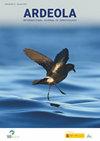墨西哥哈利斯科沿海热带森林中军事金刚鹦鹉对森林斑块的差异利用
IF 1.2
4区 生物学
Q2 ORNITHOLOGY
引用次数: 4
摘要
总结。墨西哥哈利斯科州的Bahía de Banderas包含重要的植被区域,用于军事金刚鹦鹉Ara militaris的维持和筑巢。然而,该地区的森林并不是被军用金刚鹦鹉随意使用的。本研究旨在评估金刚鹦鹉筑巢/栖息或取食的森林斑块与金刚鹦鹉不在的区域在植物区系组成、多样性和结构上的差异。在热带次落叶林的16个样地进行了野外采样。金刚鹦鹉使用和避免的斑块的区系组成差异有统计学意义。使用区域的多样性大约是避免区域的两倍。在使用过的地点的森林中,有大量的物种被记录为它们的食物,除了非食物物种,如Oxandra lanceolata,一种可能是金刚鹦鹉栖息地的重要组成部分的树。相比之下,在避开区域的优势物种是那些与受干扰区域有关的物种,它们不为金刚鹦鹉提供食物。我们的研究结果表明,金刚鹦鹉会选择森林碎片来应对干扰,利用森林斑块提供合适的筑巢和觅食机会。-Flores-López, E., Montero-Castro, j.c., Monterrubio-Rico, t.c., Ibarra-Manríquez, G., López-Toledo, L.和Carlos Bonilla-Ruz, C.(2020)。墨西哥哈利斯科沿海热带森林中军事金刚鹦鹉(鹦鹉科)对森林斑块的差异利用。中国生物医学工程学报,37(6):423-432。本文章由计算机程序翻译,如有差异,请以英文原文为准。
Differential Use of Forest Patches by the Military Macaw Ara militaris (Psittacidae) in Coastal Tropical Forests of Jalisco, Mexico
Summary. Bahía de Banderas in Jalisco, Mexico, contains important vegetation areas for the maintenance and nesting of Military Macaws Ara militaris. However, the forests of the region are not used randomly by Military Macaws across the landscape. This study aimed to evaluate differences in floristic composition, diversity and structure among forest patches used by the macaws for nesting/ roosting or for feeding, and at sites from which the macaws are absent. Field sampling was conducted in 16 plots of 1,000m2 of tropical subdeciduous forest. Statistically significant differences were found in the floristic composition between patches used and avoided by Military Macaws. The used areas were approximately twice as diverse as the avoided areas. The forests at used sites presented a great abundance of species registered as part of their diet, in addition to non-food species such as Oxandra lanceolata, a tree that may be an important component of macaw habitat. In contrast, the dominant species in avoided areas are those associated with disturbed areas and do not provide food for Military Macaws. Our results indicate that Military Macaws select forest fragments in response to disturbance, using forest patches that offer suitable opportunities for nesting and feeding.—Flores-López, E., Montero-Castro, J.C., Monterrubio-Rico, T.C., Ibarra-Manríquez, G., López-Toledo, L. & Carlos Bonilla-Ruz, C. (2020). Differential use of forest patches by the Military Macaw Ara militaris (Psittacidae) in coastal tropical forests of Jalisco, Mexico. Ardeola, 67: 423-432.
求助全文
通过发布文献求助,成功后即可免费获取论文全文。
去求助
来源期刊
CiteScore
2.30
自引率
6.20%
发文量
16
审稿时长
>12 weeks
期刊介绍:
Ardeola: International Journal of Ornithology is the scientific journal of SEO/BirdLife, the Spanish Ornithological Society. The journal had a regional focus when it was first published, in 1954. Since then, and particular during the past two decades, the journal has expanded its thematic and geographical scope. It is now a fully international forum for research on all aspects of ornithology. We thus welcome studies within the fields of basic biology, ecology, behaviour, conservation and biogeography, especially those arising from hypothesis-based research. Although we have a long publication history of Mediterranean and Neotropical studies, we accept papers on investigations worldwide.
Each volume of Ardeola has two parts, published annually in January and July. The main body of each issue comprises full-length original articles (Papersand Review articles) and shorter notes on methodology or stimulating findings (Short Communications). The publication language is English, with summaries, figure legends and table captions also in Spanish. Ardeolaalso publishes critical Book Reviewsand PhD-Dissertation Summaries; summarising ornithological theses defended in Spain. Finally there are two Spanish-language sections, Ornithological News; summarising significant recent observations of birds in Spain, and Observations of Rare Birds in Spain, the annual reports of the Spanish Rarities Committee.

 求助内容:
求助内容: 应助结果提醒方式:
应助结果提醒方式:


